Last updated on May 5th, 2023
Bears, belonging to the family Ursidae, are majorly found throughout the Northern Hemisphere and partially in the Southern Hemisphere. Despite their weight, they are very skilled at running, climbing, and swimming. With these interesting facts about bears, let us explore more about these mammals.
Essential Bear Facts
1. Range and Diversity
Eight bear species are scattered across the globe: polar bears, giant pandas, sun bears, sloth bears, spectacled bears, brown bears, Asian black bears, and North American black bears.
2. Size and Weight
Sun bears are the smallest with most adults only reaching at 4 ft and 60 lbs. Polar bears are the largest with some becoming positively gigantic at 10 ft and 1,700 lbs.
3. Life Expectancy
Out in the wild, bears can live for up to 25 years. In captivity, they can live twice as long with enough food and care.
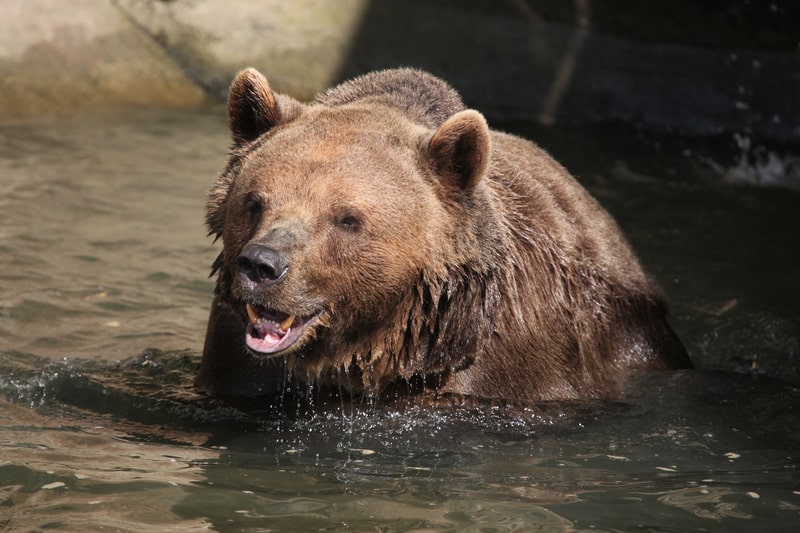
4. Survival of the Fattest
Bears hibernate during winter to cope with food shortage. With a lower metabolism, they can last for several months without eating and drinking. They survive on body fat instead. Did you know that the average hibernator weighs only 70 grams? Hibernation is a means of energy conservation, and different species hibernate due to various reasons including food shortage and temperature fluctuations.
5. Bear Birth
In the middle of hibernation, females will rise to push out as many as four cubs. The tiny hairless newborns are completely dependent on their mothers for milk and warmth.
6. Bear Diet
Bear diets vary based on species and environment. For example, giant pandas love bamboo, polar bears hunt seals, American black bears feed on berries, sloth bears eat termites, and brown bears catch salmon.
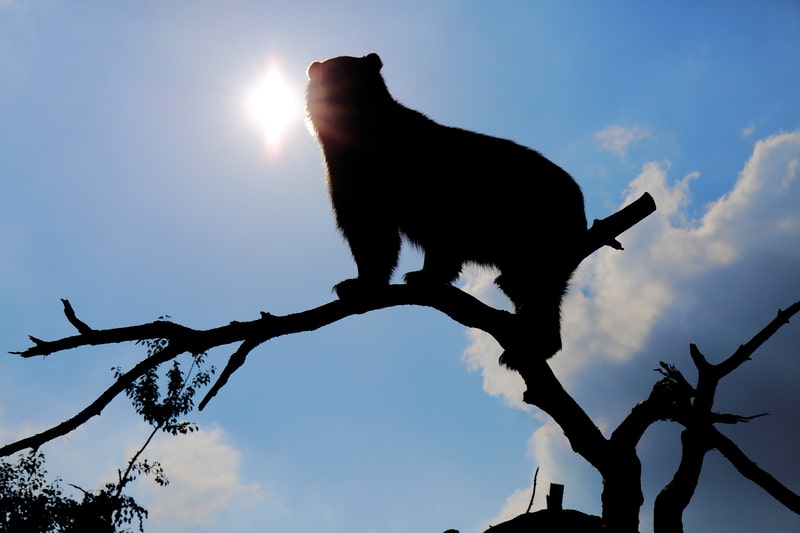
7. Walking Upright
Bears are more comfortable moving on all fours, but they can walk using only their hind legs for short distances. From afar, you may think they were ordinary humans.
8. Signs of Intelligence
Bears have larger brains than most land mammals. They are intelligent enough to cover their tracks, hide from hunters, and camouflage their scent. They can even remember places where they got food for up to 10 years. However, did you know that the largest brains are those of sperm whales, weighing about 8 kg? A human brain is around 1.3 to 1.5 kg. Brain size tends to vary according to body size.
9. Colorful World
Studies show that bears see the world in color and their eyes reflect light in the dark. These help them find good food while they roam at night. Not all mammals can see colors. Bears are among the few that have color vision, which helps them find food faster and spot the difference between similar items. Bear have a reflective layer at the back of their eyes that improves night vision. This also produces the bright eyeshine when you flash a light on them at night. You can observe the same thing with cats, dogs, and other animals.
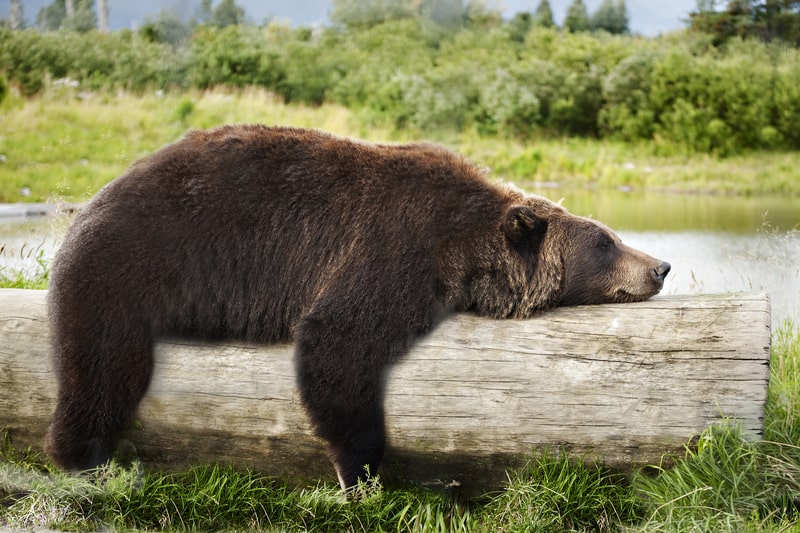
10. Group Name
A group of bears is referred to as a “sloth” of bears. It comes from the Middle English word for “slow”. That’s quite inaccurate since bears can run as fast as 40 mph.
11. Hybrid Bears
Climate change is making bears wander into each other’s territories more often. This has led to more hybrids such as the offspring of brown bears and polar bears.
12. Bear Constellations
Two constellations are named after bears: Ursa Major (Great Bear) and Ursa Minor (Little Bear). Both found in the northern sky, explorers use them to navigate in the dark.

13. Bear Temperament
Only the polar bear is a true carnivore while others are omnivores that often prefer plant-based food. Many people are afraid of bear attacks but these creatures are more likely to run away during encounters.
14. Don’t Feed the Bears
Bears often return to food sources. Don’t feed them if you don’t want them coming around often. Don’t leave pet food and garbage in the open for too long either.
15. Camping with Bears
Bears can smell food from miles away. Airtight containers such as bear canisters can hide the scent. Cooking and washing should be far from the tent so wandering bears won’t disturb your sleep.
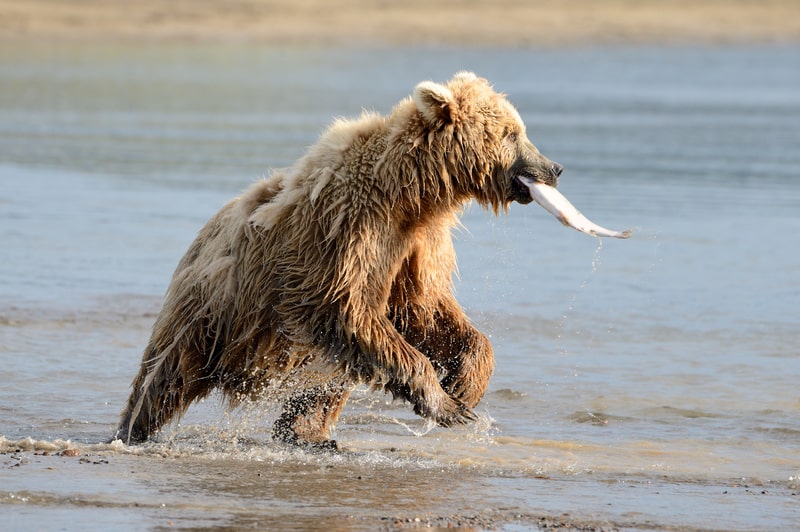
16. Bear Spray
Bear spray should only be used directly on the eyes or nose of an attacking bear. It should not be sprayed on the ground, tent, or on random objects because the smell can attract bears.
17. Playing Dead
Playing dead is only effective when trying to escape a grizzly defending her cubs, not when a predatory bear is hunting you down as its prey (throwing rocks and sticks is more appropriate).
18. Make Some Noise
When moving around areas with bears, it is a good idea to make some noise by singing or talking loudly. This gives them time to avoid you, thus preventing awkward encounters.
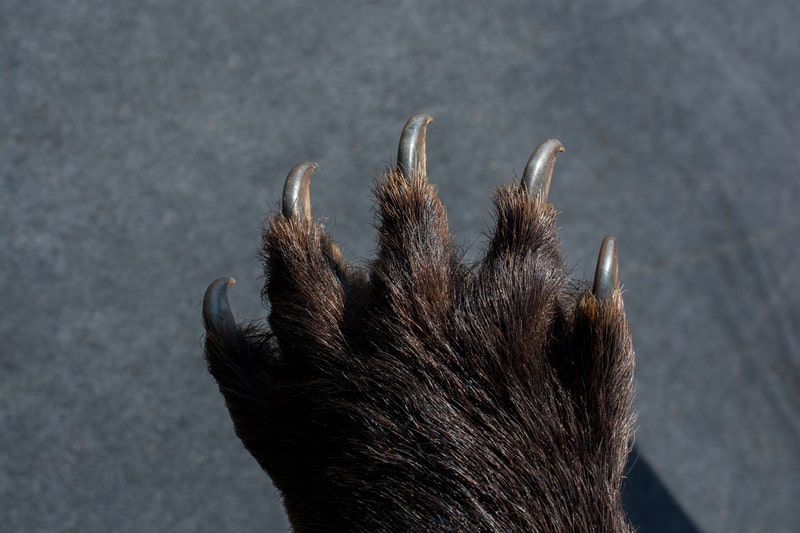
19. Bears Like It Natural
Natural food is their preference. They will eat human food if available, but they go back to their usual fare in the wild if they can get these.
20. Bears Show Intention
Bears are predictable and intelligent creatures. They typically vocalize and use body language to show their intentions. By learning their behaviors, people can feel safer and more confident around them.
21. Common Traits
Bears are known for having a big body, short tail, broad head, thick legs, small eyes, and round ears. Their long, shaggy fur comes in different colors including black, brown, red, cream, and white.
22. Koalas Aren’t Bears
Koalas are often mistaken for bears, but they are actually marsupials that carry their babies in a pouch. Koalas are more closely related to wombats and kangaroos.
23. The First Bear
The “dawn bear” is considered as the first bear ever to walk the Earth, dating as far back as 10 million years ago.
24. Lone Wanderers
Bears like to roam on their own. They usually spend the first three years of their lives with their mother. As soon as they can, they move away, find their own territory, and live alone.
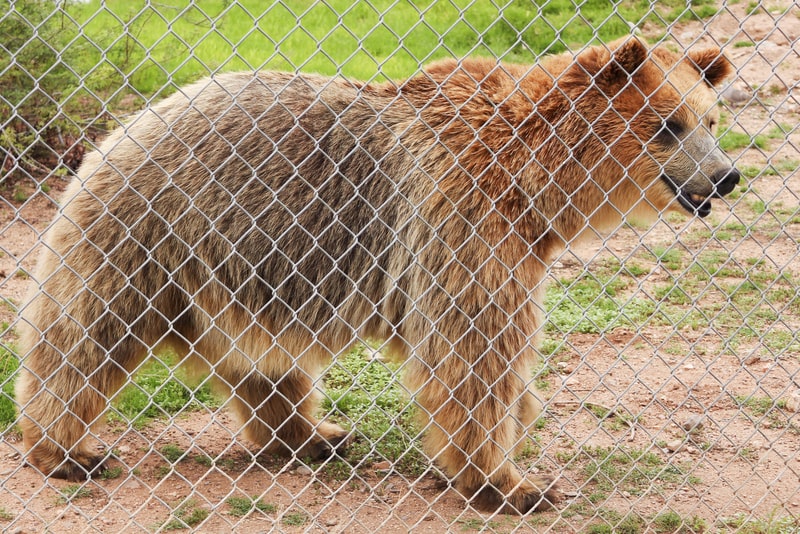
25. Survival Skills
Bear cubs learn survival skills from their mother, who may take them around while gathering food. They see which plants are good to eat, where to find them, and which foods are available in each season.
26. Largest Bear Ever
Scientists discovered an ancient bear that weighed between 2,000 and 3,500 pounds. That is several times larger than polar bears!
27. Small Ears
Bear ears are small compared to their body size and are often covered in fur. This helps prevent them from getting cold. The downside is that bears don’t have good hearing.
28. Smell Over Sight
Bears rely on their keen sense of smell more than their eyesight. They use it to follow the scent of potential mates and their prey.
29. Bear Terms
Male bears are called “boars”, while females are called “sows”. Their babies are “cubs”. If you see a group of bears, then you can refer to them as a “sloth”.
Polar Bear facts

30. What’s in a Name?
An 18th century explorer coined the term “polar bear”. Scientists also use the Latin “Ursus maritimus” (sea bear) and the Greek “Thalarctos” (bear of the Northern Sea).
31. Two Layers of Fur
Polar bears developed two layers of fur to survive the Arctic climate. The inner layer’s plush hair traps body heat. The outer layer adds insulation and repels cold water.
32. Polar Bears are Not White
Their fur is actually transparent up-close. The hair shafts have a clear hollow core that reflects visible light. The reflections make them seem white and help them blend in with the snowy environment.
33. Fat for Warmth
Polar bears swim in frigid waters to hunt and travel. Since wet fur is a poor insulator, they rely on body fat for warmth instead. This layer can be up to 11.4 cm thick.
34. Specialized Paws
With 30 cm paws, they can walk on thin ice without falling. They can also swim fast by using these as paddles. The two-inch claws help catch prey and add traction on ice.
Black Bear facts

35. Range and Population
Around 750,000 black bears are found in North America. They live in forests from the northern regions of Alaska and Canada, to the southern regions of Florida and Mexico.
36. Color Coat
Despite their name, black bears are not always black. Many of them have brown or blonde fur. A few have white fur, such as the Kermodes of coastal British Columbia.
37. Long Distance Swimmer
Although they mostly stay on land, black bears can swim in fresh water for at least a mile and a half. Some are known to swim over nine miles.
38. Winter Dens
Black bears create winter dens at the base of hollow trees, under the snow, or inside rock crevices. In warmer regions, they may stay high up on trees. They scratch the bark off for soft bedding material.
39. Life Cycle
Cubs grow quickly with most weighing 80 lbs by their first year. They will stick with their mothers for around 18 months or until she is ready to mate again. Adult bears lead solitary lives.
Brown Bear facts

40. Belly Holes
Alaskan brown bears lay down to rest after feeding. To stay comfortable despite their large bellies, they make it a point to dig belly holes. Bigger bellies get deeper holes!
41. Food Intake
Brown bears can eat up to 90 lbs of food each day from summer to fall, enabling them to gain 6 lbs of fat daily. This is in preparation for winter hibernation.
42. Brown Bear Distinction
Brown bears range in color from black to blonde. What sets them apart from black bears is their prominent shoulder hump, dish-shaped face, and longer claws.
43. Naming Origin
The scientific name for brown bears is Ursus arctos. This is actually redundant since both words mean “bear”. “Ursus” is Latin while “arctos” is the Greek form.
44. Bear Cubs
Mating happens throughout the fall. Embryos only develop after females enter their winter den. After eight weeks, cubs are born tiny and lightweight at under half a pound.
Spectacled Bear facts
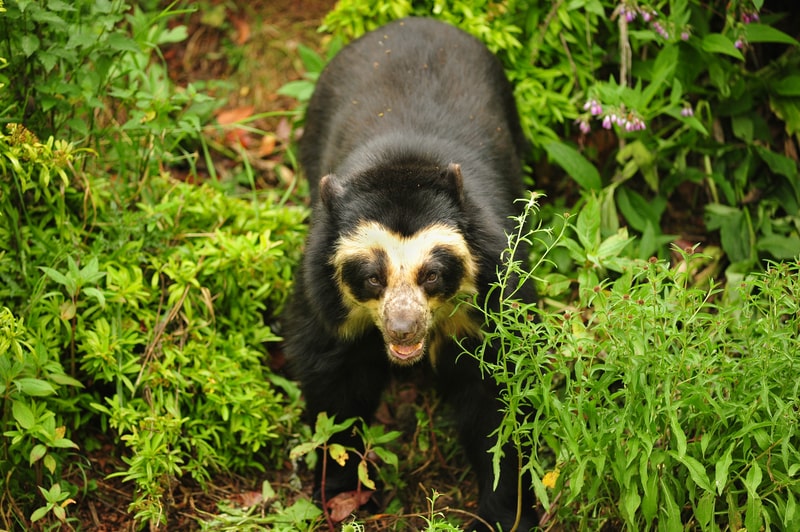
45. Southern Bears
Nearly all bear species live in the Northern Hemisphere. The only exception is the spectacled bear. This can be found across the Andes Mountains in South America, ranging from Venezuela to Argentina.
46. Eye Rings
Their name comes from the distinctive light-colored rings around their eyes that look like big eyeglasses. Each one has a facial marking that is unique like a human fingerprint.
47. Shy Introverts
Spectacled bears are extremely shy. They would rather stay in isolated cloud forests and climb 14,000 feet high to avoid contact, only coming down to search for food.
48. Night Bears
They are active at night, harvesting fruits, cacti, berries, and honey. They may climb trees and wait for fruits to ripen for days. Only 5% of their diet is meat including birds, rodents, and insects.
49. Pop Culture Fame
The most well-known spectacled bear is Paddington, the creation of children’s author Michael Bond. The first book was published in 1958. It has evolved into TV shows and feature films.
Sloth Bear facts
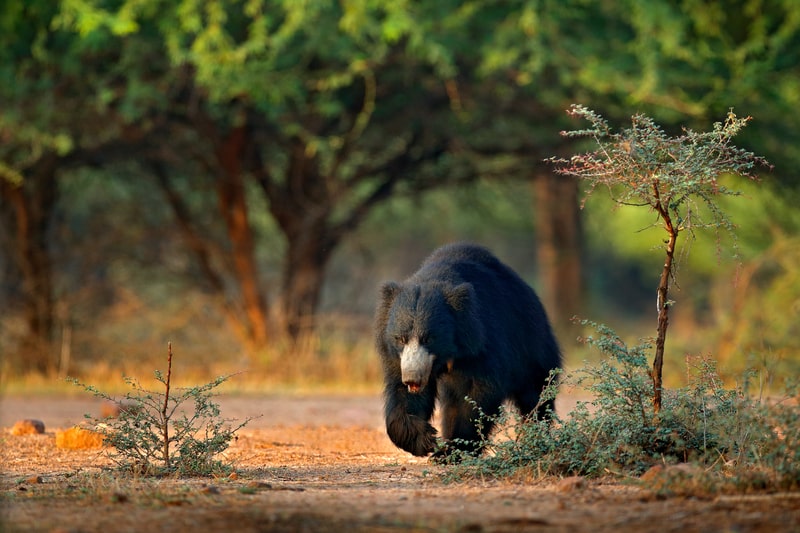
50. Natural Air Filter
Humans wear face masks to prevent the inhalation of unwanted particles. Sloth bears deal with this by closing the nostrils on their own. This is useful in blocking dust while raiding termite nests.
51. Mothers and Cubs
Most bear species let their cubs roam around on their own. In contrast, sloth bears regularly carry their young cubs on their backs to protect these from predators.
52. Bear Teeth
The gap in their front teeth provides a clear path when sucking ants and termites. Sloth bears can easily grind fruits and insects with small molars. Only their canines are large for defense.
53. Bear Fur
Sloth bears live in warm regions around South Asia like India, Bhutan, Sri Lanka, and Nepal. Their shaggy coats protect from insect bites and help cubs hold onto their mothers.
54. Bear’s Bread
To feed larger cubs, mothers regurgitate a sticky mixture of partially digested honeycomb, wood apples, and jack fruit. This hardens into a bread-like mass with a circular shape and dark yellow color.
Giant Panda facts

55. Panda Parleys
Despite being solitary animals, they can interact through sounds when surrounded by other pandas. They could bark, chirp, chomp, bleat, and honk to communicate. They are the most vocal of all bears.
56. Carnivore Digestive System
Pandas are nonstop eaters. Their bodies have trouble digesting cellulose, so they compensate with high volume consumption. They spend 12-14 hrs a day devouring up to 40 kg of bamboo.
57. Giant Panda Art
These bears are highly revered in Chinese culture. Ancient art from the region dating back thousands of years ago include depictions of giant pandas.
58. Panda Handstands
Pandas leave scents on trees and rocks to notify others about their presence. The scent gland is under their short tail. Males will often do a handstand so that their rear end can rub higher areas.
59. Pseudo Thumb
Pandas hold bamboo securely while eating. They have six digits on each paw: five fingers and one opposable pseudo-thumb. It is really just an enlarged wrist bone but it gets the job done.
Sun Bear facts
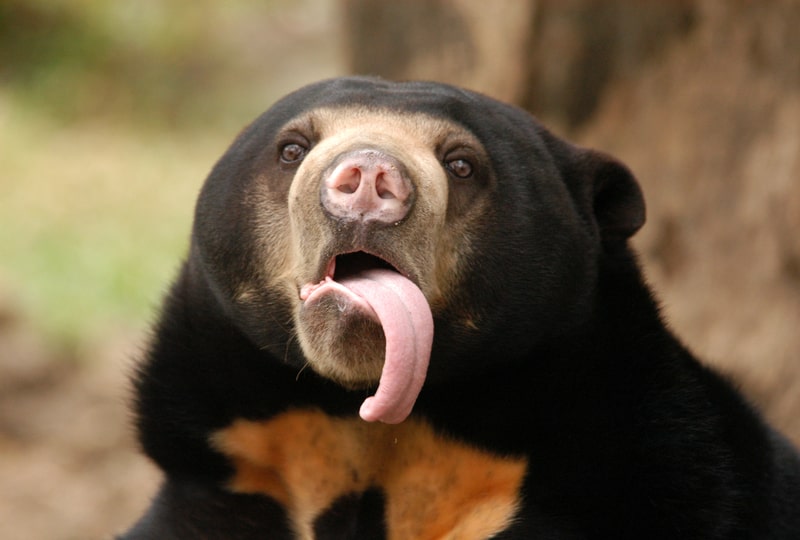
60. Honey Bear
All bears love honey but none more than the sun bears. Their long snouts and tongues can extend up to 25 cm to extract honey and larvae from inside beehives.
61. Distribution and Habitat
These small bears live in tropical rainforests across Southeast Asia including Thailand, Vietnam, and Malaysia. They love places that are hot and humid.
62. Fur Coat
Their dense black fur is short enough to prevent overheating. It protects them from insect bites and bee stings while feeding. The sleek fur ensures that dirt, mud, and rain can slide right off.
63. Elevated Beds
Sun bears spend most of their time high up on tree branches. They keep themselves comfortable by building beds using leaves and twigs — quite a luxurious accommodation in a forest.
64. Rising Sun
The gold-colored patch on their chest is said to resemble the rising sun, and local legends have cemented this myth. The scientific name Helarctos Malayanus means “sun bear of Malaya” in Greek.
Asian Black Bear facts
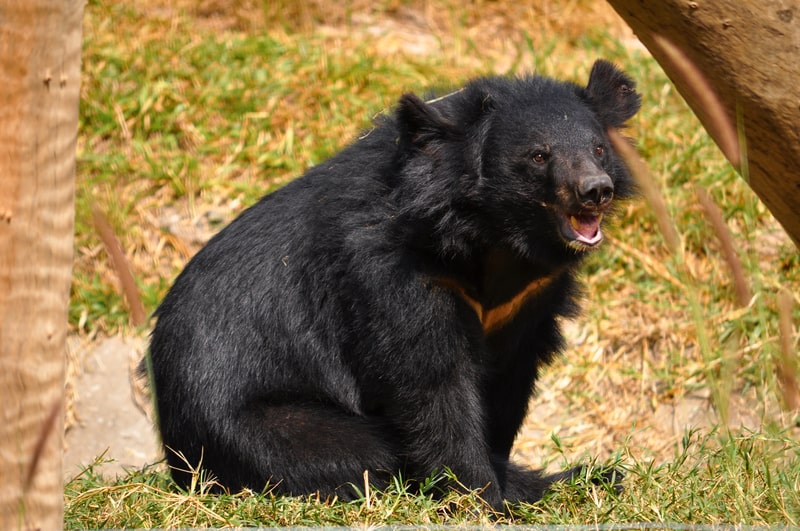
65. Unique Traits
Asian black bears are easily identified through the patch of white crescent on their chest, a light brown muzzle, and long bell-shaped ears that stick out sideways.
66. Strong Climbers
The black bears of Asia have strong upper bodies that are great for climbing trees. In fact, they can continue to climb even if they have broken hind legs.
67. Best in Bipedal
Other bear species can only walk on two legs for short distances before reverting to all fours. Asian black bears can maintain it for more than a quarter of a mile.
68. Distribution and Habitat
The bears can be found in forests around the foothills of the Himalayas, China, and mainland Southeast Asia. Some are in Afghanistan, Pakistan, Japan, Korea, Taiwan, and the Russian Far East.
69. Moon Bear
One of its scientific names is “Selenarctos Thibetanus” which translates to “moon bear of Tibet”. This is in reference to the prominent white crescent on their chest.
. . . continue reading on the next page
